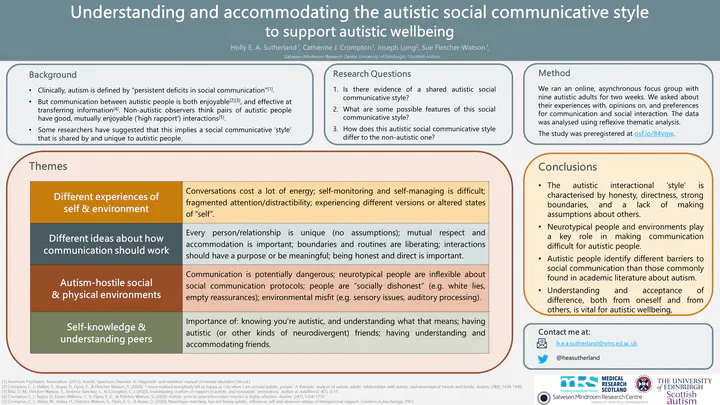Understanding (and accommodating) an autistic social communicative ‘style’ to support autistic wellbeing

Abstract
Introduction. Autistic people often find communication and social interaction difficult. These difficulties are linked to negative health and wellbeing outcomes, including loneliness, social isolation, and poor mental health. However, recent research suggests that autistic social communicative difficulties may occur due to a mutual misalignment between autistic and non-autistic people regarding communicative needs and expectations (i.e. due to a different communicative style). Therefore, improved understanding of an autistic communicative style could reduce miscommunication between autistic and non-autistic people, thus improving wellbeing and mental health outcomes for autistic people. Methods. To explore the autistic communicative style, we ran an online, asynchronous, forum-style focus group with 9 autistic adults over two weeks. Questions posed to the group focused on five topics- (1) signalling social interest; (2) what feels rude, polite, natural, and unnatural during communication; (3) differences in talking to autistic vs. non-autistic people; (4) what makes a social interaction a positive one; and (5) anything else the participants wanted to say. Results. The data was analysed using thematic analysis, and five themes were identified- (1) External factors affecting communication (perceived danger, inflexibility of non-autistic people, dishonesty of others, unwritten ‘social skills’, environment); (2) Internal factors affecting communication (fragmented attention, low social energy, self-monitoring/managing, variable sense of self); (3) Using intellect to overcome challenges; (4) Protective factors against an unpleasant communicative experience (autistic friends, accommodation, autistic identity); and (5) Strongly held principles of autistic communication (honesty, purposeful conversation, unique interactional styles, boundaries/routines, and mutual accommodation). Discussion. Our results point to difficulties created by a social environment designed to non-autistic norms, and by fundamental differences in the autistic experience/expectations of social interaction. They also suggest that understanding, accommodation, and acceptance by non-autistic people can reduce these difficulties. Non-stigmatising descriptions of the autistic social communicative style may improve autistic communication, social interaction, and wellbeing by improving non-autistic people’s understanding.